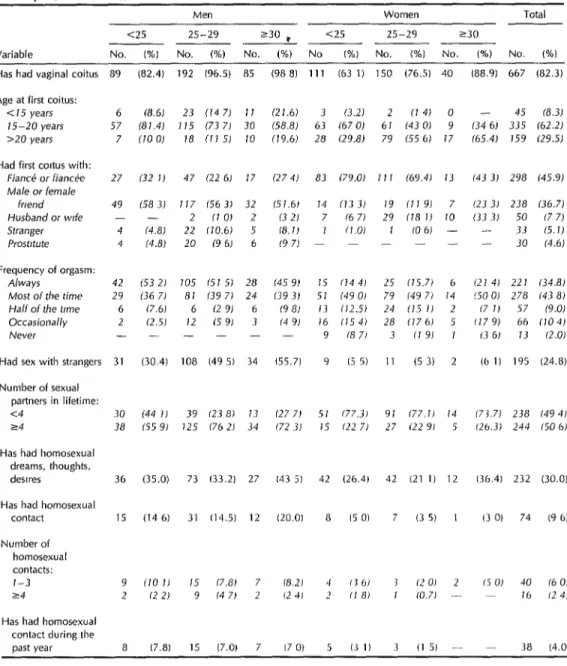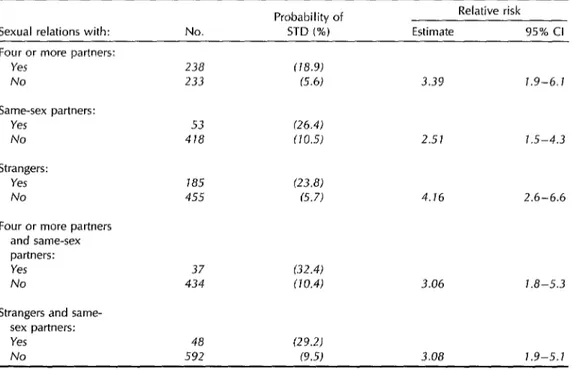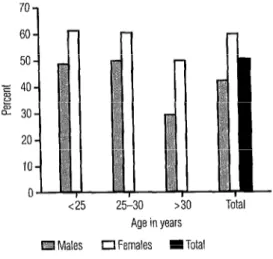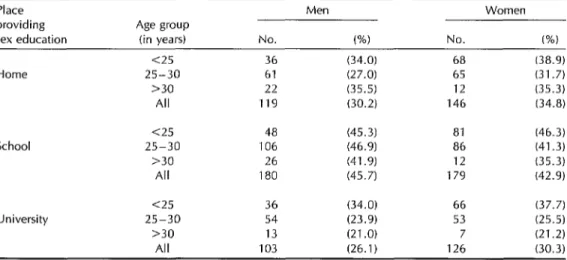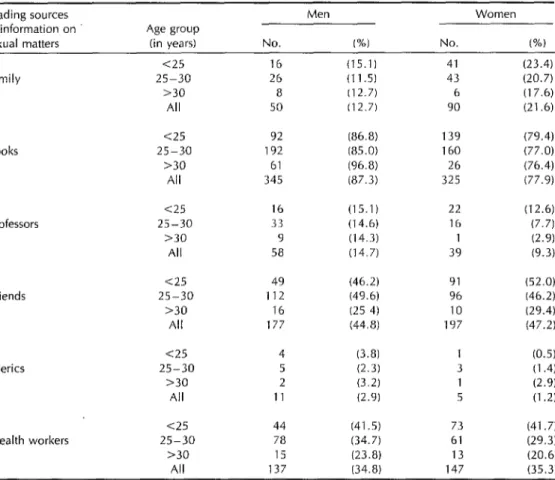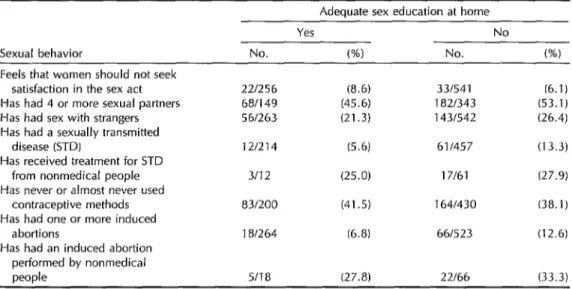Sexual Behavior and Health Problems
in University
Students,
University
of Antioquia,
19911
Luz
ZULOAGA POSADA,* CECILIA
SOTOV~LEZ,~
& DIVA JARAMILLO VBLEZ*
Authorities at the University of Antioquia, Colombia, felf it would be advisable to institute a student orientation program aimed at preventing health problems resulting from risky sexual behavior related to new cultural trends. The purpose of the work reported in this article was to collect information on the existing situation and provide appropriate advice to the Health Division of fhe University Welfare Office.
For this purpose a survey was conducted with fhe voluntary parficipafion of 836 students enrolled in fheir final year of sfudy. A survey form containing 45 questions designed to elicit demographic and sexual behavior data was self-administered anonymously by the par- ticipating students.
Among the participants who were sexually acfive, 10.9% (17.2% of the men, 3.3% of
the women) said they had contracted some variety of sexually transmitfed disease [STD). The most common diagnoses were gonorrhea (42%), genital warts (23%)‘ and genital herpes (19%). The risk of contracting STD was 4.2 fimes greater in those reporting sex with strangers; 3.4 times greater in fhose reporting four or more sexual partners; and 2.5 times greater in those reporting homosexual relations, as compared to sfudents not practicing such behaviors. Some 28.4% of 790 survey respondents or fheir parfners had been pregnant; 49%
of fhese pregnancies had terminafed in abortions, 77% of these being induced abortions. Only 51.3% of the survey participants reported customay use of contraceptives, those most frequenfly cited being condoms (by 32% of the users), pills (20%), the rhythm method (18%), and extravaginal ejaculation (17%).
Generally speaking, it appears that participating studen fs)ad received litfle sex education. To obtain information, the+y had turned primarily to friends and books. Those who said they had received adequafe sex education af home participated somewhat less frequently in risky behaviors buf appeared a little less apt to have used contraceptives and a little more apt to think that women should not seek satisfaction in fheir sexual relationships.
If has been recommended that the university establish programs to augment sfudenf knowledge in fhis area, prevent STDs and unwanted pregnancies, and encouragqresponsible exercise of sexuality.
I
n human beings, the expressed andshared sexual function constitutes both a means of reproduction and a system of communication. Sexual behavior is influ- enced by such factors as individual person-
ality, social class, and the moral structure of the social and family environment (Z-3).
The onset of puberty currently occurs at an earlier age than in previous gen- erations, while stable unions are estab- lished at a later age, commonly at the
conclusion of academic studies. Conse-
‘Edited version of an article previously published in Spanish in the Bolefin de In Oficim Snnifarin Pnrm- mericann, Vol. 119, No. 3, September 1995. Reprint requests and other correspondence should be ad- dressed to Luz Zuloaga Posada, Universidad de
Antioquia, Carrera 53 No. 62-65, Apartado a&e0 1226, Medellin, Colombia.
‘University of Antioquia, School of Nursing, Epi- demiology Group.
quently, a widened gap exists between the age of physiologic maturation and the age at which sexual activity is considered culturally acceptable. This implies a need
to postpone sexual expression within a
profoundly contradictory social frame-
work where punitive and repressive mo- rality coexists with an eroticism exalted by commercial media advertising that in turn influences the liberalization of sex- ual behavior (4-6).
This cultural tendency raises the po- tential for contracting sexually transmit- ted disease (STD) and contributes to an increase in unwanted pregnancies among teenagers and single women, this latter being associated with increased risk of
complications during pregnancy and
childbirth and of abortion. Such situa-
tions produce adverse health conse-
quences and may lead to sexual dys- function (7, 8). To prevent these problems, young people need to understand the im- portance of exercising their sexuality both rationally and responsibly.
The purpose of the work reported here was to identify health problems associ- ated with the sexual behavior of students at the University of Antioquia, as a pre- liminary step toward advising the Health Division of the University Welfare Office
about implementation of a student ori-
entation program in preventive health.
MATERIALS
AND METHODS
During August and September 1991, a descriptive survey was conducted in the population of young adults at the Uni-
versity of Antioquia who were complet-
ing the final year of their academic study
programs. The survey instrument con-
sisted of a questionnaire (Annex 1) con- taining 45 questions designed to deter- mine (1) the sources of student information about sexual matters, (2) prevailing pat- terns of sexual behavior and their health consequences, (3) the frequency and types
of sexually transmitted diseases (STDs)
in the study population, (4) contraceptive practices in the study population, and (5) ’
rates of pregnancy, complications of
pregnancy, and abortion-including in-
duced abortion. This instrument was
tested initially on a group of 50 students who had not reached their final academic year, and was then modified on the basis of that experience.
Of the 1 578 university students who were in their final year of academic stud- ies in 1991, 836 agreed voluntarily to par- ticipate in the survey. These students were enrolled in 53 of the 54 undergraduate academic programs (lasting between 8 and 13 semesters each) that were then offered by the university. Students from the school
of philosophy were excluded because of
difficulty determining who was in the fi- nal academic year, as their study pro- gram did not have the same academic structure as the other programs.
Initially, information was obtained about course schedules for the final year of
study, and appropriate teachers were
asked for permission to administer the
survey questionnaire during the first half- hour of class. Before beginning, the in- vestigators told the participants about the
study’s aims, explained how the ques-
tionnaire was to be completed, and en- couraged them to respond honestly.
The questionnaires were distributed in the classrooms of all courses included in the final year of each academic program. The researchers remained in the class- room in order to answer any questions that the students might have while com- pleting the questionnaire. Each partici- pant self-administered the questionnaire and, when finished, deposited it in a con- tainer placed in the classroom for that pur- pose, thus helping to ensure anonymity.
The information obtained from the sur- vey was analyzed using the Epi Info com-
puter program, version 5 (Centers for
Disease Control and Prevention, Atlanta, Georgia, USA, 1990). For analytical pur- poses, the sample was divided into three
age groups, these being under 25, 25 to 30, and over 30. The percentage distri- bution of demographic, sexual behavior, sex education, and contraceptive practice variables, as well as the probabilities of
pregnancy and STD transmission, were
calculated for each age group by sex. The relative risk of contracting a sexually transmitted disease through a given type of sexual behavior was calculated using 95% confidence intervals.
RESULTS
Demographic
Analysis
Of the 836 students surveyed, 812 in- dicated their age and sex. Of the latter, 394 (48.5%) were men and 418 (51.5%) were women; while 281 (34.6%) were less than 25 years old, 398 (49.0%) were 25 to 29, and 133 (16.4%) were 30 or over.
Analysis of marital status by sex was
based on 808 individuals (416 women and
392 men) who provided the necessary in-
formation. Among the women, 105
(25.2%) indicated a marital status involv- ing family commitment (married, in a free
union, separated, or widowed), as com-
pared to 73 (18.6%) of the men.
Sexual Behavior
Table 1 summarizes the data gathered on the sexual behavior of the 810 survey participants responding to this part of the questionnaire. In all, 667 (82.3%) indi- cated they had had vaginal coitus, with the percentage of men who did so ex- ceeding that of women in all age groups,
Initial coitus was said to have occurred at ages ranging from 7 to 37 years, but the men in all three age groups tended to have experienced initial coitus earlier than the women. On the average, women under age 25 reported having had their first coitus earlier than women in the older age groups. In contrast, men under age
25 tended to have had their first experi- ence slightly later in life than men in the older groups.
With regard to first sexual partners,
women more frequently reported having
first coitus with their fiance, while men more frequently reported having first coi- tus with a female friend to whom they were not engaged. It was also more char- acteristic of women to have had initial coitus with their husbands (16%) than for men to have had it with their wives (1%).
Conversely, more men (17%) than
women (0.6%) reported having initial coi- tus with a prostitute or stranger. Fewer men under age 25 than 30 or over (9.5% versus 17.8%) reported having their ini- tial coitus with a prostitute or stranger.
Regarding orgasm, the sexually active men reported achieving orgasm most or all of the time they had sex; none re- ported never achieving orgasm. On the other hand, 15% of women said they rarely or never achieved orgasm in their sexual relations.
With respect to numbers of lifetime
sexual partners, a far higher percentage of men (70.6%) than of women (23.2%) said they had had four or more sexual partners. Of all the students responding to survey question 15 (see Annex), 50.6% said they had had four or more partners.
Of the entire survey population, 30.0%
cited homosexual dreams, thoughts, or
desires, while 9.6% reported having had homosexual contact. Among men, homo- sexual contacts had increased during the preceding year, and an analysis of homo- sexual behavior by age revealed that the frequency of such behavior had increased
with age among men, while among
women this was a more frequent behav- ior in younger age groups.
With regard to numbers of homosexual contacts, 2.4% of the sexually active stu-
dents who answered question 18 re-
ported having had four or more homo- sexual contacts, with higher percentages of men than women respondents report-
Table 1. Sexual experiences reported by 810 survey subjects, by age and sex, who were university students in their final year of academic studies at the University of Antioquia (Antioauia, Colombia), 1991.
Variable
Men Women Total
<25 25-29 230 p <25 25-29 230
NO. (%I NO. WA) No. (%) No (%) No. (%I No. P/o) No. (%I Has had vaginal coitus 89 (82.4) 192 (96.5) 85 (98 8) 111 (63 1) 150 (76.5) 40
Age at first coitus: < 15 years 75-20 years >20 years
6 (8.6) 23 (147) II (27.6) 3 (3.2) 2 fJ 4J 0 57 (81.41 115 (73 7J 30 (58.8) 63 (67 OJ 61 (43 OJ 9 7 (10 0) 18 (71 5J 10 (19.6) 28 f29.8) 79 (55 61 17 Had first coltus with:
FiancC or Wan& Male or female
friend Husband or wfe Stranger Prostrtute
27 132 JJ 47 (22 6J 17 (27 4) 83 (79.0) 71 1 (69.41 73
49 1583) 117 (563) 32 (51.6) 14 (73 3J 19 (7191 7 2 (10) 2 (32) 7 (6 71 29 118 I! 10 4 (4.8) 22 (10.6) 5 (8.7) 7 fi.0) I (0 6J - 4 (4.8) 20 (9 6J 6 (97) - - - - -
Frequency of orgasm: A/ways
Most of the time Half of the t/me Occasionally Never
42 153 2J 105 (51 5J 28 (45 9) 15 (144) 25 (15.7J 6 29 136 7) 81 (39 7J 24 (39 31 51 (49 0) 79 (49 7J 14 6 (7.61 6 (291 6 f9 81 13 (12.5) 24 (15 II 2 2 (2.51 I2 (59) 3 (4 91 16 f154J 28 (17 6J 5 - - - 9 (87) 3 fJ 91 I
Had sex with strangers 31 (30.4) 108 (49 51 34 (55.7) 9 I5 5) I1 (5 3) 2
Number of sexual partners in lifetime: <4
24
30 144 7) 39 (23 81 13 (27 71 57 (77.31 91 (77.1) /4 38 155 9) 125 (76 21 34 (72 3J 75 (22 7J 27 122 9) 5
Has had homosexual dreams, thoughts,
desires 36 (35.0) 73 (33.2) 27 I43 5) 42 (26.4) 42 (21 1) 12
Has had homosexual
contact 15 (14 6) 31 (14.5) 12 120.01 8 (50) 7 (3 5) 1
Number of homosexual contacts: 1-3 24
9 110 II I5 (7.8) 7 (8.21 ‘I (36) 3 (2 0) 2 2 (221 9 (47) 2 (24) 2 (18) I CO.71 -
Has had homosexual contact during the
past year 8 (7.8) 15 (7.0) 7 170) 5 (31) 3 (1 5) - - 38 (4.01 (88.91 667 (82.3)
- 45 (8.3) (34 6J 335 (62.2) (65.4) 159 (29.5)
(43 3J 298 (45.9)
(23 3J 238 (36.7) (33 3J 50 (7 7) - 33 (5.1) - 30 (4.6)
(21 4) 22 I (34.8) (50 0) 278 (43 8)
(7 7) 57 (9.01 (17 YJ 66 (104)
13 6J 13 (2.0)
(6 1) 195 (24.8)
(73.7) 238 I49 4J 126.31 244 (50 6J
(36.41 232 (30.0)
(3 0) 74 (9 6)
(5 01 40 16 OJ - I6 12 4)
ing this in all age groups. The maximum s
frequency (4.7%) of respondents report-
exually Transmitted
Diseases
ing four or more homosexual contacts oc- Of 793 students who responded to this
curred among men 25 to 29 years old. section of the survey, 73 (9.2%) said they
had had a sexually transmitted disease (STD). This problem had been more fre- quent among men than among women in all age groups. The greatest risk was found among men over 30, of whom
32.1% reported having had an STD.
Overall, the percentage of sexually active
respondents reporting STD experience
was 10.9% (17.2% of the men and 3.3%
of the women). Of those with this ex-
perience, 32% reported more than one episode. The disease most frequently re- ported was gonorrhea (42%), followed by venereal warts (23%) and genital herpes
(19%). A noteworthy percentage of the
respondents reporting STD cases (16.8%) said their disease had been treated by someone other than a physician.
As Table 2 indicates, the relative risk of contracting an STD was found to have been 1.9 to 6.1 times greater among those
reporting four or more sexual partners
than among those reporting fewer part-
ners. The relative STD risk was also 1.5 to 4.3 times greater among those who
reported homosexual relations, and 2.6
to 6.6 times greater among those who reported having coitus with strangers.
Contraceptive
Use
Regarding contraceptives, 51.3% of the sexually active respondents said they used contraceptives all or most of the time, while 37.9% said their partners used con- traceptives all or most of the time (Fig- ures 1 and 2). As both charts show, cus-
tomary use of contraceptives appeared
more common among women than among
men in all age groups. The most fre-
quently used contraceptive methods were, in decreasing order, condoms (32%), pills (20%), the rhythm method (18%), extra- vaginal ejaculation (17%), intrauterine devices (8%), and creams or supposito-
ries (7%). Some survey participants re-
ported using more than one method.
Table 2. Sexually experienced student respondents who reported whether they had ever contracted a sexually transmitted disease (STD), by three types of sexual behavior. Cl = confidence interval.
Sexual relations with: Four or more partners:
Yes
No
Same-sex partners: Yes
No
Strangers: Yes
No
Four or more partners and same-sex partners: Yes
No
Strangers and same- sex partners: Yes
No
No.
238 233
53 418
185 455
37 434
48 592
Probability of STD (%)
f78.91 6.61
(26.4) 170.5)
(23.8) (5.7)
(32.41
(JO.4)
(29.2) (9.5)
Relative risk Estimate 95% Cl
3.39 7.9-6.1
2.51 7.5-4.3
4.16 2.6-6.6
3.06 7.8-5.3
3.08 7.9-5.1
Figure 1. Percentages of male and female Figure 3. Percentages of male and female respondents reporting sexual activity who said respondents reporting sexual activity who said they used contraceptive methods all or most of they had become pregnant (white bars) or had a the time, by age and sex. partner who became pregnant (dark bars).
) >30 TC
Males
Age in years 0 Females I Total
Figure 2. Percentages of male and female respondents reporting sexual activity who said
50 40 E
zs 30 CY
20 10 0
<2!i 25-30 >30 Age In years
Partners of respondents 0 Respondents
The responses provided by 790 stu-
dents on this subject revealed a high rate
of complications during pregnancy and
childbirth (Table 3). Approximately half their sexual partners used contraceptive methods of all the pregnancies (49.1%) had ter- all or most of the time, by age and sex of the minated in abortion, and 84 (77.1%) of
survey respondents. these were induced abortions. Of the to-
25-30 >30 To Age in years
Males 0 Females I Total
Pregnancy and Abortion
In all, 28.4% of the female survey re- spondents and female partners of the male survey respondents (Figure 3) were found to have been pregnant. As the figure in-
dicates, pregnancy was reported for a
higher percentage of the former than the latter, a difference that was smallest in the youngest (under 25) age group.
tal number of induced abortions, 70% were performed by physicians, 14.5% by health
personnel other than physicians, 13.3%
by people outside the health field, and 2.2% by individuals whose profession was unknown.
Sex Education
The responses to survey questions 6 through 8 (see Annex) showed that less than half the students surveyed felt they had received adequate sex education at home, in school, or in college. As Table 4 indicates, the subject appears to have been less adequately covered at home and college than in school, with slightly higher percentages of women than men report- ing adequate sex education at each of the three places.
To obtain information on sexual topics, high percentages of the survey respond- ents said they had read books or asked
Table 3. Female student respondents and female partners of male respondents (n = 790) who had been pregnant and who reported whether they had experienced complications during pregnancy, complications during delivery, or miscarriage/abortion-including induced abortion.
Probability for all 790 Pregnant women (n = 222) respondents or therr
Complications partners (%) No. % Pregnancy complications (5.4) 43 (19.4) Delivery complications (4.1) 32 (14.4) Miscarriage/abortron (13.8) 109 (49.1) Induced abortron (10.6) 84 (37.8)
Table 4. Student respondents, by age group and sex, who reported receiving adequate sex education at home, in school (high school), or at the university.
Place providing sex education
Age group
(in vears) No. Men
(%I
Women
No. (%)
Home
<25 25-30 230 All
School
<25 25-30 >30 All
University
<25 25-30 >30 All
36 (34.0) 68 61 (27.0) 65 22 (35.5) 12 119 (30.2) 146
48 (45.3) 81 106 (46.9) 86 26 (41.9) 12 180 (45.7) 179
36 (34.0) 66 54 (23.9) 53
13 (21.0) 7
103 (26.1) 126
(38.9) (31.7) (35.3) (34.8)
(46.3) (41.3) (35.3)
(42.9)
(37.7) (25.5) (21.2) (30.3)
friends (Table 5). Women tended to rely more than men on their families, while men tended to rely more on books. Gen- erally speaking, those surveyed said they consulted very little with clerics, family members, or teachers, while over a third said they obtained information from health workers. Some limited age difference was
observed, with survey subjects in the
youngest (under 25) group showing a
greater tendency to consult health work-
ers, family members, teachers, and
friends.
quencies of high-risk behaviors (having
four or more sexual partners or sex with strangers), induced abortions, STDs, and performance of induced abortions or STD treatments by people outside the health field (Table 6). However, relatively higher
percentages also reported feeling that
women should not seek pleasure from sexual activity and stated that they never or almost never used contraceptives.
DISCUSSION
The group of students who reported The survey results tended to affirm that
receiving an adequate sex education at there had been a liberalization of sexual
home also reported somewhat lower fre- conduct, especially among the younger
Table 5. Student respondents, by age group and sex, who reported consulting their families, books, teachers, friends, clergy, or health workers to obtain information on sexual matters. The instructions for answering the relevant survey question (see Annex, questron 9) asked the respondents to check only one source of information,
but
most checked more than one.Leading sources Men Women
of information on Age group
sexual matters (in years) No. (%I No. 66) <25 16 (15.1) 41 (23.4)
Family 25-30 26 (11.5) 43 (20.7)
>30 8 (12.7) 6 (17.6)
All 50 (12.7) 90 (21.6)
Books
<25 25-30 >30 All
92 (86.8) 192 (85.0) 61 (96.8) 345 (87.3)
139 (79.4) 160 (77.0) 26 (76.4) 325 (77.9)
Professors
<25 25-30 >30 All
16 (15.1) 33 (14.6) 9 (14.3) 58 (14.7)
22 (12.6) 16 (7.7) 1 (2.9) 39 (9.3)
<25 49 (46.2) 91 (52.0)
Friends 25-30 112 (49.6) 96 (46.2)
>30 16 (25 4) 10 (29.4) All 177 (44.8) 197 (47.2)
<25 4 (3.8) 1 (0.5)
Clerics 25-30 5 (2.3) 3 (1.4)
>30 2 (3.2) 1 (2.9)
All 11 (2.9) 5 (1 .a
~25 44 (41.5) 73 (41.7)
Health workers 25-30 78 (34.7) 61 (29.3) >30 15 (23.8) 13 (20.6) All 137 (34.8) 147 (35.3)
respondents. This change is seen in ini- tiation of sexual activity at younger ages, an increased frequency of sex before mar- riage, and a greater number of sexual partners. This trend toward sexual lib- eration of young people appears to be
universal, to judge by reports from a
number of different countries (6-13). It should be noted that an attitude
characterized by
machismo
(male domi-nance in sexual matters) tended to pre- vail, as indicated by the greater promis- cuity and sexual activity of the male survey
respondents. The only behavior ob-
served that might be regarded as sug- gesting some modification of this attitude
306 Bulletin
of
PAHO 2914), 2995was a decline in initial male sexual con- tact with prostitutes or strangers (see Table 1). It is possible that this could be ex-
plained by changing attitudes among
women having made women more ac- cessible as sexual partners.3
Generally speaking, this survey found that a higher percentage of participants had homosexual relations than had been found by other studies of Colombian uni- versity populations (24, 25).
3G6mez A. Conducta sexual en la poblacibn univ- ersitaria de Colombia. (Unpublished photocopied
Table 6. Opinion as to whether women should seek pleasure in the sex act and sexual experiences of student respondents, by whether they reported receiving adequate sex education at home.
Adequate sex education at home
Sexual behavior
Feels that women should not seek satisfaction in the sex act Has had 4 or more sexual partners Has had sex with strangers Has had a sexually transmitted
disease (STD)
Has received treatment for STD from nonmedical people Has never or almost never used
contraceptive methods Has had one or more induced
abortions
Has had an induced abortion performed by nonmedical people
Yes No
No. w No. (%)
221256 (8.6) 331541 (6.1)
681149 (45.6) 182f343 (53.1) 561263 (21.3) 1431542 (26.4)
121214 (5.6) 611457 (13.3) 3112 (25.0) 17161 (27.9)
831200 (41.5) 1641430 (38.1)
181264 (6.8) 66/523 (12.6)
5118 (27.8) 22166 (33.3)
Regarding STDs, the study findings are consistent with gonorrhea frequencies re- ported by various other sources. Accord- ing to WHO estimates for developing countries, two-thirds of all gonorrhea cases occur in individuals under age 25 (7); and according to a 1985 study by Gonzalez
(E), gonorrhea was the most frequent
venereal disease among university stu-
dents in Barranquilla, Colombia. Also, a 1975 study by Alzate (14) found that 49% of a population of medical students with coital experience had had some type of STD, and that 87.5% of the latter had
contracted gonorrhea. The same author
observed in 1980 (23) that the frequency of STDs among sexually experienced sub- jects had dropped to 25.3% but that most of these subjects (78.9%) had had gon- orrhea. In addition, results obtained by Soto (16) in 1986 on Peruvian university students found STD frequencies of 23% for men and 7% for women but did not refer specifically to gonorrhea.
Regarding conception, it may be said
that the high percentage of sexually ac- tive students lacking appropriate contra-
ceptive protection exposes considerable
numbers to unwanted pregnancy and to
the need to resort to abortion to resolve the situation, a practice that poses ele- vated health risks. The infrequent use of contraceptives in Latin America generally has been confirmed by a number of stud- ies conducted in various countries (6, 8,
10, 11, 13, 15, 27, 18).
The unwanted pregnancies that result
from engaging in sex without the mutual responsibility of both participants give rise to problems of a biological, psychologi- cal, and social nature, especially among
unstable couples and young women (4, 8, 29). Our study findings support the theory that men in Colombia tend to have little concern about the reproductive ef- fects of sexual relations, commonly leav-
ing responsibility for pIanning to the
woman. In addition, the risk of un-
wanted pregnancy is quite high, since
contraceptive use is far from universal and some of the methods used by the
young population involved afford little
security against conception.
One way to resolve the problem is by interrupting the pregnancy, a practice that in Colombia entails illegal abortion and
commonly causes critical health prob- lems for women. The illicit nature of this practice makes it hard to estimate the rate of clandestine abortions in Colombia with precision, but it has been suggested that
at least 8% of all pregnancies in young
women between the ages of 15 and 19 end in induced abortion (20). At the Ma- ternal-child Institute of BogotB, 20% of 3 000 women hospitalized in 1980 for abortion complications were less than 20 years old. This percentage was higher
(23%) in 1987 (8).
The limited sexual education received
by the students surveyed appears typical
of Latin America, as has been indicated
in several studies by other workers (20, 11, 15). One of those studies identified
friends and books as being the sources most commonly consulted by students (12). Another, also in agreement with ours, found that sex practices had fewer ad- verse consequences for students who felt they had received adequate sex educa-
tion at home (10).
In general terms, human sexuality is a
function like any other-with organic,
psychological, and social facets that allow individuals to reproduce, experience sat- isfaction, and relate to their fellow hu-
man beings. However, expression of the
sexual function is regulated in accord- ance with sociocultural norms transmit-
ted through education received from birth onward, as part of an integral process in
which individuals adopt the attitudes and
values of the society in which they live. It is therefore reasonable that sexual ed- ucation should be the responsibility of
the parents as socializing agents, and that
such education should subsequently be
reinforced by formal institutions respon- sible for the instruction and health of the
general population (l-11).
In accordance with the findings of this survey, it is therefore recommended that
the Health Division of the University Welfare Office take the following actions:
308 Bulletin of PAHO 29(4), 1995
Offer programs to complement the
sexual education received by stu-
dents at home, in order to promote stable interpersonal relations and a healthy, responsible exercise of sex- uality.
Implement programs for controlling
sexually transmitted diseases that will
contribute to their early diagnosis and
timely treatment.
Make instruction in family planning
readily available to students and sub-
sidize provision of appropriate
materials.
REFERENCES
1.
2.
3.
4
5
6
7
8.
Acuria A. La funcibn sexual; el sexo coma funcibn: un concept0 bisico. Rev Lationam Sexol (Cali) 1988;3(2):179-193.
Gomensoro A. Sexualidad y educaci6n. in: Primer Seminario Colombiano de Sexuali- dad en la Adolescencia, Bogota’, Colombia, 1 a 3 de septiembre de 1988. Bogot&: Editorial Presencia; 1988: 101- 206.
Lutz E. Problemdtica de la sexualidad en la adolescencia en America Latina: situa- ci6n general en el area latinoamericana. In: Primer Seminario Colombiano de Sexuali- dad en la Adolescencia, Bogota’, Colombia, 2 a 3 de sepfiembre de 1988. Bogota: Editorial Presencia; 1988:107-112.
Lutz E. Aspectos psicolbgicos de la sex- ualidad en la adolescencia. In: Primer Sem- inario Colombiano de Sexualidad en la Ado- lescencia, Bogota’, Colombia, 1 a 3 de sepfiembre de 2988. Bogoth: Editorial Presencia; 1988:29-32.
Krasner L. La modificacibn de1 compor- tamiento y la revolucibn sexual: movi- mientos sociales en interaccibn. Reo La- flonam Psicol (Bogota) 1977;9(1):117-120. Aller AL. Pr&zticas de iniciaci6n sexual y anticoncepci6n en un grupo de j6venes 1imeAos. Rev Lafinoam Sexo/ (Cali) 1990; 5(2):155- 197.
Katasky M. Juventud y sexo. In: Drogas: motivo de preocupacion. Bol Oficina Sanit Panam 1985;98(4):347-530.
9. Hayashi K. Comportamiento, actividad sexual y fertilidad en adolescentes de1 Ja- pan. Bol Epidemiol Anfioquia-Medellirr 1989;14(1-2):86-90.
15. Gonzalez JM. Comportamiento sexual de1 universitario. Rev Lafinoam Psicol 1985; 17(1):6-56.
10. Valenzuela MS, Herold J, Morris L, Lopez IM. Encuesta de salud reproductiva en adultos jdvenes de Gran Santiago. Bol Of- icina Sanit Panam 1992;112(1):19-30. 11. Brostein E. Comportamiento sexual en una
poblacion de la ciudad de Mexico. Ginecol Obsfef Mex 1980;48(280):383-401.
16. Soto V. Comportamiento prematrimonial de1 universitario peruano, estudio com- parativo 1972-1974. Rev Lafinoam Sexol (Cali) 1986;1(2):181-202.
12. Duarte A. Mis experiencias en investiga- cion sobre sexuaiidad en adolescentes. In: Primer Seminario Colombiano de Sexualidad en la Adolescencia, Bogofci, Colombia, 1 a 3 de sepfiembre de 1988. Bogota: Editorial Pre- sencia; 1988:75-80.
17. Dfaz R, Pick S. Conducta sexual y anti- conceptiva de 10s adolescentes en la ciu- dad de Mexico con respect0 a la reiacion de su pareja. Rev Lafiuoam Sexol (Cah) 1989;4(1):7-17.
13. Alzate J. Comportamiento sexual de es- tudiantes de medicina, comparacion con cinco arias de intervalo. In: Primer Con- greso Colombiano de Sexologia, Cali, Colom- bia, 5 a 9 de agosto de 1981. Bogota: Editorial Presencia; 1982:155-163.
18. Ortiz G. Algunas disfunciones sexuales de la mujer. Paper presented to the Sec- ond Latin American Congress on Behav- ior Analysis and Modification, Bogota, Colombia, 23-27 June 1979.
19. Herrera F, Dfaz J. Embarazo en la ado- lescente. Ginecol Obsfet Mex 1980;48(285): 59-68.
14. Alzate H. Comportamiento sexual de 10s 20. Prada E, Singh S, Wulf D. Adolescenfes de estudiantes de medicina. Acfa Med Colomb boy, padres de1 mariana en Colombia. New 1977;2(2):111-118. York: Alan Guttmacher Institute; 1988.
Annex 1. The questionnaire presented to the participating University of Antioquia students (English translation).
UNIVERSITY OF ANTIOQUIA OFFICE OF UNIVERSITY WELFARE NURSING FACULTY, EPIDEMIOLOGY GROUP
This survey form is strictly anonymous. Do not sign it. Answer it and place It in the indicated box. The information obtained by this survey will be used by the Health Drvision of the University Welfare Office to design a student health program. Therefore, it is important that your responses be sincere.
Demographic variables
1. Year of university program ~ 2. Year of entenng the university 3. Sex : M 1
F
q
2 4. Age in complete years5. Civil status: Cleric 1 Free union 4 Single
a
2 Separated
a 5
Married 3 Widowed 6
Sexual education
Do you think that you have received adequate sexual educatron in your: 6. Home? Yes 1
q
7. School? Yes 1q
8. University? Yes1
No
2 No 2 Noq
29. What source do you turn to preferentially to obtain information about sex? Family member
1
Friends 4Books 2 Clerics 5
Teachers
q
(choose only one) 3 Health personnel
q
6Sexual behavior
10. Have you had vaginal coitus? - 11. At what age drd you have your first coltus? - Yes 1
q
(If no,No 2 proceed to number 14)
12. With whom did you have first 13. How often do you experience orgasm coitus? during vaginal coitus?
Fiance or fiancee 1
El
Always 1
Male or female friend 2 Most of the time 2 Wife 3 Half of the time
El 3
Stranger 4 Occasionally 4
Prostitute 5 Never 5
14. Do you believe a woman should seek pleasure in the sex act? Yes 1 No
q
2 15. How many different people have you had vaginal coitus with during your life?16. Have you had sexual contact with strangers? Yes 1 No
q
2 17. Have you had dreams, thoughts, or desires of a homosexual nature? Yes1
No
q
2 18. Have you had homosexual contacts? 19. How many times?Yes
1
(If no,No
q
2 proceed to number 21)20. Have you had homosexual contacts within the past year? Yes 1 No
q
2Annex 1. (Continued)
21. Have you suffered venereal diseases? 22. How many times? Yes 1
No
q
(If no,
2 proceed to number 29) Which ones?
23. Syphilis: Yes
q
1 24. Gonorrhea: Yesq 1
25. Genital herpes: YesNo
2 No 2 Noq 1
226. Chancroid: Yes
q
1 27. Genital warts: YesNo 2 No
q
1 2 28. Who treated you?
A doctor
Other health personnel (nurse, pharmacist) Empiricists (friends, relatives)
Yourself
Use of contraceptives 29. How frequently do you use contraceptive methods?
Always 1
Most of the time
Half of the time 0
Occasionally 2 Never 3 Don’t know 30. How frequently does your sex partner use contraceptive methods?
Always 1
•l
Occasionally Most of the time 2 Never Half of the time 3 Don’t know
1
2
I
3 4If you or your sex partner use some contraceptive method, indicate which of the following: 31. Pills: Yes 1
No
q
32. Intrauterine device: Yes 1
2 No
q
33. Condom: Yes 1
2 No
q
234. Creams or suppositories: Ye5 1 No
q
35. Rhythm method: Yes 1
2 No
q
236. Ejaculation outside Yes 1
q
37. Don’t know: Yes 1q
Others (which?):the vagina: No 2 No 2
Pregnancies and abortions 38. If you are a woman, Have you been pregnant?
If you are a man, Has your partner been pregnant? Yes 1
No
q
(If no,
2 stop here) 39. How many times? Were there complications during the:
40. Pregnancy? Yes 1
No
q
(If yes, which?) 41. Delivery Yes 1 (If yes, which?)
2 No
q
242. Did any of the pregnancies terminate in an abortion? Yes 1
q
(If no, No 2 stop) 43. How many?44. Were any of them induced? Yes 1 No
q
,
(If no, 2 stop) 45. Who induced the abortion? A doctor
Other health worker Another person Don’t know
